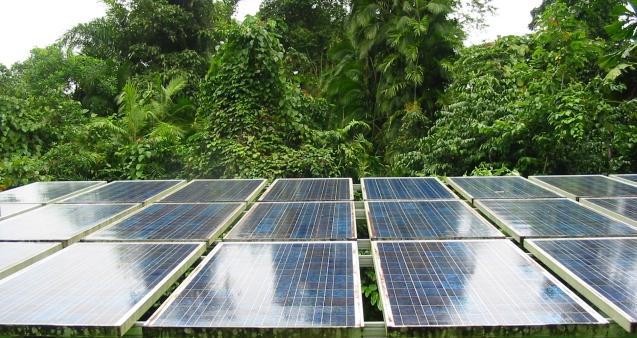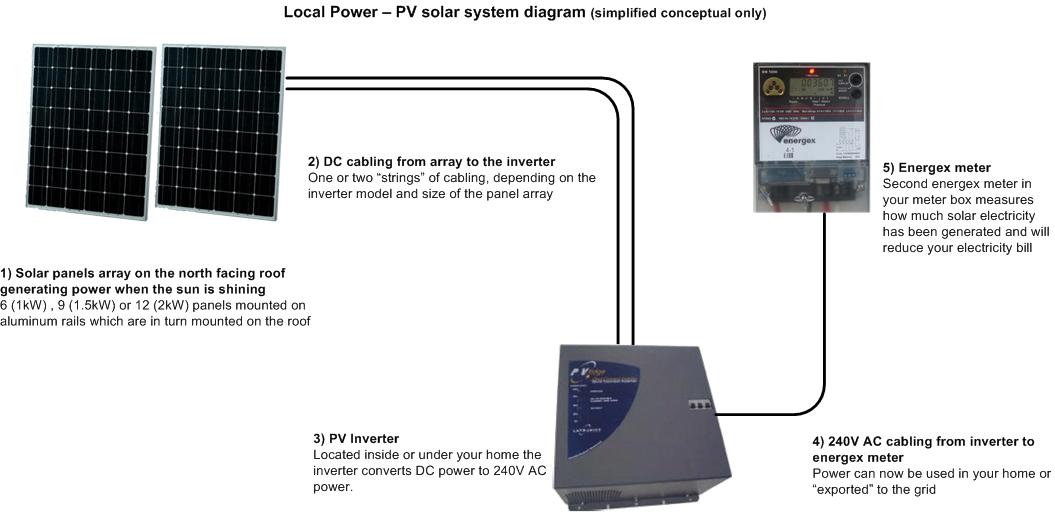|
Local Power negotiated a Buying
Group Offer for interested Brisbane home owners and
community groups who would like to generate electricity by installing PV
solar panels on their roof.
A
Buying Group is a way to achieve significant savings in price, by
buying the components in bulk, installing them in bulk, and doing all
the administration and rebate paperwork in bulk and at community rates.
All savings were passed onto
the Buying Group, apart from a transparent administration fee to cover
costs.
The Local Power Buying Group #1 closed on 12 February 2008 with the
majority of the 140 installations completed by July 2008.
Buying Group #2 closed on 5 December 2008 with 130 orders and the
majority of installations were completed in April 2009. Buying
Group #3 closed on 22 May 2009 with over 100 orders.
If you would like to learn more about the Local Power Buying Groups please click on the Buying Group Offer
link in the left menu.
If you are just interested in being on our mailing list to get updates, please leave your email
address and other details here.

What is PV Solar?
PV
(PhotoVoltaic) solar panels generate electricity directly from
sunlight, which can then be used to power your electric appliances and
lights. Click on this diagram to see a bit more information on how
it all works:

In a grid connected PV system, the type that Local Power
is interested in, excess electricity which is not used at the time it's
generated, can be fed (& sold) back to the electricity grid to be used by other
homes and businesses. With a large PV solar panel system and an
energy efficient home, a home
can generate more electricity than it uses, effectively becoming self
sufficient in electricity using renewable energy.
If there is an electricity blackout, the grid connected
PV system turns off as a safety measure to protect the linesman working
on fixing the grid. So having a PV Solar system won't spare you
from future blackouts.
In a standalone PV system, usually out in the bush where
there is no electricity grid, there are additional components like
batteries. In that case, the excess energy is stored in the
batteries and used at night time and on cloudy days.
Doesn't the government offer incentives?
There are three different incentives which help decrease the cost of
a PV Solar system and help pay for it over it's lifetime. These
incentives are Rebates, RECs and Feed-in tariffs (FiT).
With these various incentives, the costs of PV solar
systems have come down to the point that many homes and community groups
will be able to afford to install PV solar and make a positive
contribution to the environment by reducing greenhouse gases.
Rebates
In May 2007 the Federal government PVRP rebate for PV solar system increased
again to up to $8000/home for a 1kW system (with no additional rebate
for larger systems) & $12000 for community groups for a 2kW system.
In May 2008 this rebate was renamed as the SHCP and became "means
tested" at $100,000 family income because it was becoming "too
overheated". This rebate will end in June 2009 and be replaced by
the Solar Credits Scheme.
RECs
Renewable Energy Certificates (RECs) are also created
when PV solar systems are installed. Some solar installation
companies rebate these back to the customer to reduce the price of
the system. RECs have a market based price, so can change from
week to week. For a 1kW system recently selling the RECs has
attracted an additional $990 incentive. Larger systems have
received an additional $990 for each additional kW. RECs are not
means tested and are payable to anyone who installs PV Solar or Solar
Hotwater including residents, businesses and community groups. You
can read some more information about RECs and their historical price by
clicking here.
From July 2009 the SHCP $8000 rebate will end, but for 3
years RECs will have a 5x multiplier applied to them for the first 1.5kW
of any system, before tapering off in each subsequent year to 4x, 3x, 2x
and finally no multiplier. At the current REC price a 1kW system
will attract an incentive of about $4950, while a 1.5kW system will
attract an incentive of about $7425. For a more details comparison
of the current rebate and the modified REC scheme please
click here.
Feed-in tariffs
The Queensland government has implemented a
"Feed-in tariff", which is where electricity retailers pay more than
the retail price for renewable electricity generated from PV solar
systems. This helps to reduce the financial payback time of a PV
solar system.
The SA and Queensland governments have implemented a feed-in tariff with
2 times the SA
retail rate, i.e. 44c/kWh, but only for the energy which is exported
to the grid (import-export or net scheme). You can read about the details of the Queensland 44c/kWh FiT scheme here.
The Victorian Government scheme will be 60c/kWh (import-export) but
system size will be limited to 3.2kW. The ACT government will implement
a feed-in tariffs
with
3.88 times the ACT retail rate which is around 57c/kWh for all the
energy generated (gross scheme). The WA ALP has an
election policy of a 60c/kWh for all the energy generated (gross
scheme).
What benefits do they provide?
As a sample here is some positive environmental impact of each
system.
- 1.5kW - generates around 2196 kWh/year
- save 30% of average electricity use* or between $469 to $718/year (50%
export at 44c/kWh)
- save around 2 tonnes of CO2/year = leaving an average car in the
garage for 5 months
- save 7275 litres of water/year which the coal fired power station
would have used
- 2kW - generates around 2928 kWh/year
- save 40% of average electricity use*
- save around 3 tonnes of CO2/year = leaving an average car in the
garage for 7 months
- save 9725 litres of water/year which the coal fired power station
would have used
- 3kW - generates around 4392 kWh/year
- save 60% of average electricity use*
- save around 4 tonnes of CO2/year = leaving an average car in the
garage for 10 months
- save 14450 litres of water/year which the coal fired power station
would have used
Feed in tariffs, if implemented properly, have the potential to save
even more of your electricity bill, which will reduce the financial
payback time of the PV solar system even further.
* average electricity use is for a household who uses electricity for
hotwater and cooking. households with solar hotwater or gas hotwater and
cooking use around 50% less electricity.
Embedded or
Embodied Energy
The energy used to manufacture a product is called the product's
embodied energy. Obviously, PV solar panel manufacturers have to use
energy to make their product, and this energy will probably be generated
by fossil fuels, with the attendant emissions of green house gases (this
fact is sometimes used to downplay the value of PV solar panels).
But the good news is, after the first few years, modern
solar panels have already generated more than enough energy to
compensate for the energy that went into their manufacture (inclusive of
solar panels, frames and inverters). After that, and for the rest of
their life, the panels are producing free (no greenhouse gas cost to the
environment) renewable energy.
PV solar panels are generally
warranted at having a life of 20-25 years, but are likely to still be
working in 40 years, although at a much lower level of efficiency.
Efficiency of PV solar cells
There are several types of PV solar cells, many made of Silicon
which is also used to make computer chips, although other materials have
also started to be used due to shortages in Silicon. Different
material combinations have different levels of efficiency in converting
sunlight to electricity, and are improving over time as manufacturing
processes improve. Crystaline Silicon based cells have dominated
grid connected and standalone systems to date. Some commercially available ones
include:
Monocrystaline Silicon - 12-15%, although 24% has been
obtained in the lab
Polycrystaline Silicon - 11-14%, although almost 19% has been obtained
Thin film amorphous Silicon - 6-8%, although almost 13% has been
obtained
Cadmium Telluride CdTe - 7-10%, although 16% has been obtained
Copper Indium Gallium diselenide CIGS - 8-12%, although almost 19% has
been obtained
Will Sliver technology make solar power much
cheaper soon?
Local Power is excited by and has been following the Origin Sliver
technology, needing 90% less Silicon. Unfortunately we have heard that
it's still a few years away from commercial rollout, and won't be 90%
cheaper.
There is lots of solar innovation happening all over the world
(general process improvements, various other compounds in thin film,
multijunction etc.). A lot of ground breaking solar research
has also happened in Australia at
UNSW (PERL and finger) and ANU
(Sliver).
Although there have been shortages of silicon wafers in recent years,
suppliers are rapidly increasing production capacity which will also
help in lowering prices. Prices for solar are likely to drop 50%
over a decade or so, which has probably been the long term price trend.
By then however, governments probably won't want to offer generous
rebates (currently $8000). Local Power believes that the time is
right to go solar now.
Here are some more links to Sliver information
Origin Energy Sliver website
PESwiki - Sliver Solar Cells
Cosmos Magazine -
Slicing the Cost of Solar Power
ABC
Catalyst - Sliver Cells
|



